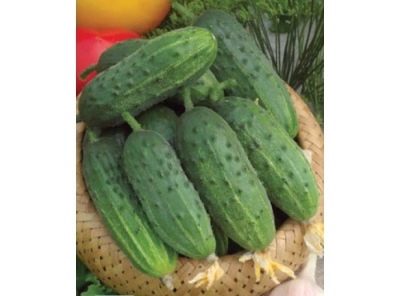
- Authors: Medvedev A.V., Medvedeva N.I., Kapustin A.A.
- Year of approval: 1998
- Growth type: vigorous
- Fruit weight, g: 82-96
- Fruit length, cm: 11
- Fruit color: green with smeared stripes up to 1/3 the length of the fruit and medium mottling
- Cucumber Mosaic Virus Resistance: stable
- Ripening terms: mid-early
- Pollination: bee-pollinated
- Fruit shape: fusiform
Cucumber Blu has been pleasing gardeners for two decades. During this time, he managed to win the respect and love of many gardeners. They choose this type of vegetable for its excellent taste and unpretentiousness in growing.
Breeding history
The described culture was born in the Crimea, at the experimental station of the Research Institute of Plant Growing. Such breeders as Kapustin A.A., Medvedev A.V., Medvedeva N.I worked on it. Golubchik was admitted to mass cultivation in 1998.
Description of the variety
This type of cucumber is considered a hybrid. It can be cultivated not only in open ground on the site, but also in temporary film structures.
Characteristics of the appearance of plants and zelents
The type of growth of Golubik is characterized by experts as indeterminate, vigorous, with an average height of 140-190 cm. The plants have impressive lengths of whip with medium branching. Pale green leaves, slightly wrinkled, wavy at the edges.
The fruits have a modest length: 11 cm. One cucumber weighs 82–96 g. It is similar in shape to a spindle. The green surface of the vegetable is covered with specks, indistinct stripes, sparse tubercles, and black thorns.
Purpose and taste of fruits
The described culture is universal, cucumbers are suitable both for eating directly from the garden, and for pickling and canning in small jars. The vegetables taste juicy, without bitterness, the flesh is crispy.
Maturation
This variety blooms mainly with female flowers, pollinated by bees. Consider it to the category of the mid-early. The fruiting period starts 42–45 days after germination.
Yield
The Golubchik variety is characterized by decent productivity, the average yield is 120-284 centners per hectare.
Growing regions
The culture has become widespread in the North Caucasian, Lower Volga regions, the Central Black Earth Region.
Landing scheme
When starting to plant a vegetable in a permanent place, the distance between the plants should be observed, it should be equal to 40 cm. The same distance should be provided between the rows.
Growing and care
It is recommended to start sowing the seeds of the Blues in the spring, at the end of April. Peat pots with a depth of about 3 cm are excellent for this purpose. You can sow 2 seeds at once in them. The container is sent to a light and warm (temperature should be 26 °) place.
When seedlings are germinated, the temperature must be reduced to 21 °. If the seedlings have 3-4 leaves, then it's time to plant in the ground. It is worth moving young plants to a permanent place at the end of May or at the beginning of June. It is better to plant Blu on the sunny side of the site or where there is partial shade.
About 1 time in 10 days, the culture needs feeding. Fertilizers can be nitrogen substances (manure, droppings), superphosphate, potassium magnesium. Experts recommend watering the considered type of cucumber 1 time in a couple of days, preferably in the evenings, and the water should not be cold. After moistening the soil, it must be loosened and hilled. The garter of vegetables is carried out on a vertical trellis, the crown of the main stem is directed downward.
Ripe fruits are removed every 2 days.This is necessary so that Blu does not outgrow, and new greens are tied.
Soil requirements
For the cultivation of this type of cucumber, a plot of land with a high level of fertility and oxygen saturation is allocated. When caring for Blu, it is important to constantly maintain the optimum moisture level in the soil.

In order to collect strong, tasty and beautiful cucumbers on your site, you need to make top dressing. Lack of nutrients can negatively affect the appearance of the plant and significantly reduce the yield. Fertilize cucumbers with organic fertilizers in combination with mineral fertilizers. With the right balance of these components and adherence to the fertilizing schedule, the cucumber yield will be maximum.
Disease and pest resistance
The described variety of cucumbers shows high resistance to such ailments as brown olive spot, cucumber mosaic, powdery mildew, downy mildew.

Despite their popularity, cucumbers are often attacked by diseases and pests. From them, cucumber plantings often die before the start of fruiting. In order to prevent this from happening, it is necessary to try to prevent ailments or get rid of them at the very beginning, having studied in detail their causes of occurrence, signs and methods of treatment.
Review overview
Gardeners speak about this variety mostly positively. They note its resistance to diseases and hot weather, excellent taste and lack of capriciousness in cultivation.





























































































